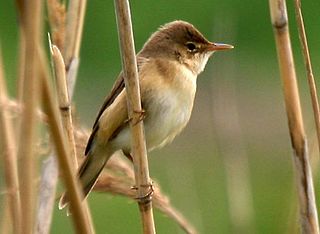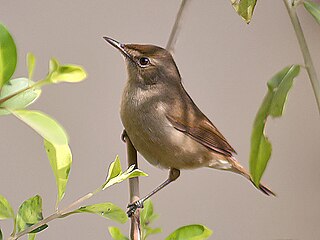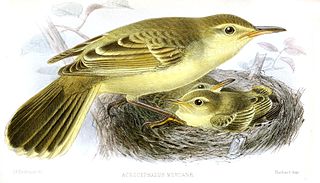
The Acrocephalus warblers are small, insectivorous passerine birds belonging to the genus Acrocephalus. Formerly in the paraphyletic Old World warbler assemblage, they are now separated as the namesake of the marsh and tree warbler family Acrocephalidae. They are sometimes called marsh warblers or reed warblers, but this invites confusion with marsh warbler and reed warbler proper, especially in North America, where it is common to use lower case for bird species.

The Eurasian reed warbler, or just reed warbler, is an Old World warbler in the genus Acrocephalus. It breeds across Europe into the temperate western Palaearctic. It is migratory, wintering in sub-Saharan Africa.

The marsh warbler is an Old World warbler currently classified in the family Acrocephalidae. It breeds in temperate Europe and the western Palearctic and winters mainly in south east Africa. It is notable for incorporating striking imitations of a wide variety of other birds into its song.

Blyth's reed warbler is an Old World warbler in the genus Acrocephalus. It breeds in the Palearctic and easternmost Europe. It is migratory, wintering in Bangladesh, India and Sri Lanka. It is one of the most common winter warblers in those countries. It is a rare vagrant to western Europe.

The moustached warbler is an Old World warbler in the genus Acrocephalus. It breeds in southern Europe and southern temperate Asia with a few in north-west Africa. It is partially migratory. South west European birds are resident, south east European birds winter in the Mediterranean breeding range, and the Asiatic race migrates to Arabia, India and Pakistan.

The clamorous reed warbler is an Old World warbler in the genus Acrocephalus. It breeds from Egypt eastwards through Pakistan, Afghanistan and northernmost India to south China, southeast Asia and south to Australia. A. s. meridionalis is an endemic race in Sri Lanka.

The Tahiti reed warbler is a songbird in the genus Acrocephalus. It used to be placed in the "Old World warbler" assemblage (Sylviidae), but is now in the newly recognized marsh warbler family Acrocephalidae. It is endemic to the island of Tahiti.

The nightingale reed warbler, or Guam reed-warbler, was a songbird endemic to Guam. It has not been seen since the 1960.

The Basra reed warbler is a "warbler" of the genus Acrocephalus. It is an endemic breeder in East and southern Iraq, Kuwait, and Israel in extensive beds of papyrus and reeds. It is easily mistaken for the great reed warbler but is a bit smaller, has whiter under parts and has a narrower, longer and more pointed bill. It winters in East Africa. It is a very rare vagrant in Europe. The call is a gruff 'chaar', deeper than a reed warbler's.

The large-billed reed warbler is an Old World warbler in the genus Acrocephalus. The species has been dubbed as "the world's least known bird". It was known from a single specimen collected in India in 1867 and rediscovered in the wild in Thailand in 2006. The identity of the bird caught in Thailand was established by matching DNA sequences extracted from feathers; the bird was released. After the rediscovery in the wild a second specimen was discovered amid Acrocephalus dumetorum specimens in the collections of the Natural History Museum at Tring. A breeding area was found in Afghanistan in 2009 and studies in 2011 pointed to its breeding in Kazakhstan and Tajikistan. One bird was found in the Baikka Wetland in Srimangal, Bangladesh on 7 December 2011.

The Acrocephalidae are a family of oscine passerine birds, in the superfamily Sylvioidea.

The black-browed reed warbler is a marsh-warbler. It was formerly included in the "Old World warbler" assemblage. The species was first described by Robert Swinhoe in 1860.

The speckled reed warbler or streaked reed warbler is an Old World warbler in the family Acrocephalidae. The species was first described by Robert Swinhoe in 1863.

The southern Marquesan reed warbler is a species of Old World warbler in the family Acrocephalidae.

The Saipan reed warbler is a critically endangered songbird of the Northern Mariana Islands. It is considered a subspecies of the nightingale reed warbler by some taxonomists. It occurs on two islands : Saipan and Alamagan. An estimated population of 2700 specimen was reported in 2009 on Saipan, and on Alamagan 950 specimen were reported in 2010.
The Mangareva reed warbler or astrolabe reed warbler is a presumed extinct songbird that existed on Mangareva in the Gambier Islands. It is known from only two specimens, and is believed to have gone extinct in the mid-19th century.

Moorea reed warbler is a species of songbird in the genus Acrocephalus. Formerly placed in the "Old World warbler" assemblage (Sylviidae), it is now in the newly recognized marsh warbler family Acrocephalidae. It was once considered a subspecies of the Tahiti reed warbler.

Garrett's reed warbler, sometimes called Society Islands reed warbler or Forster's reed-warbler was a songbird in the genus Acrocephalus. Formerly placed in the "Old World warbler" assemblage (Sylviidae), it is now in the newly recognized marsh warbler family Acrocephalidae. It was endemic to Raiatea and Huahine in the Society Islands.

The Nauru reed warbler, Acrocephalus rehsei, is a passerine bird endemic to the island of Nauru in the Pacific Ocean. It is one of only two native breeding land-birds on Nauru and it is the only passerine found on the island. It is related to other Micronesian reed warblers, all of which evolved from one of several radiations of the genus across the Pacific. Related warblers on nearby islands include the Carolinian reed warbler, with which the Nauru species was initially confused, and the nightingale reed warbler, which was formerly sometimes considered the same species.
The Aguiguan reed warbler or Aguijan reed warbler was a bird that originally occurred on the Northern Mariana Island Aguigan. It is considered a subspecies of the nightingale reed warbler by some taxonomists. Of this subspecies there never have been reports of a substantial population. In 1982 only four up to possibly 15 birds of the subspecies have been counted, and since 1995 none has been sighted, despite extended efforts to find specimens.

















